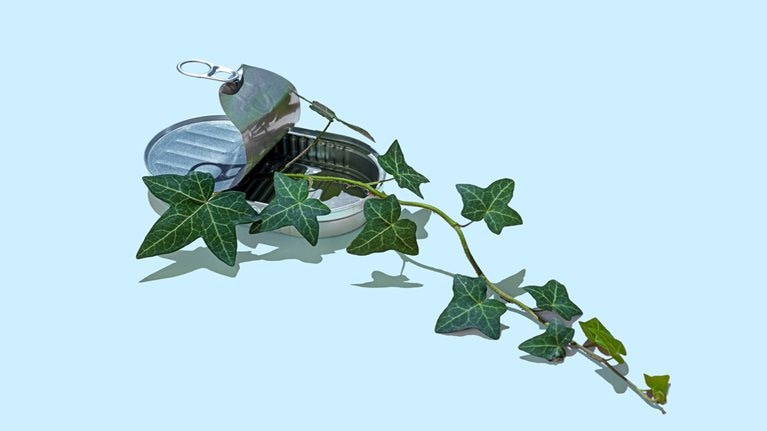
A vine of green ivy growing from an aluminum sardine tin on a light blue background.
Ever since the Industrial Revolution, we’ve consumed products in largely the same way. A company will extract or collect the resources to create a product, which consumers then buy, use, and ultimately throw away. This is known as a linear model of mass consumption.
We know now that this model of consumption has contributed to the changes in our climate that, if left unaddressed, threaten to make life much more difficult in coming decades. Every year, some $2.6 trillion worth of material in fast-moving consumer goods—80 percent of the material value—is thrown away and never recovered.
Circularity presents an alternative to the linear model. In a circular economy, resources can be used over and over again, often for the same or similar purposes.
Three major principles govern a circular economy:
- Preserve and enhance natural capital (the world’s stock of natural assets) by controlling finite resources and balancing the flow of renewable resources.
- Optimize resource yields by circulating products, components, and materials in use at the highest possible levels at all times.
- Make the system more effective by eliminating unintended negative consequences, like air and water pollution.
A circular economy is a worthy goal in itself. But it also presents an opportunity for organizations to gain a competitive edge. One McKinsey study estimates that a circular economy could represent a revenue opportunity of more than $1 trillion in Europe alone in 2050. Another McKinsey analysis estimates that shifting to circular business models may help European consumer goods companies access a value pool worth up to €500 billion by 2030. Companies, particularly consumer goods companies, which commit themselves to environmental, social, and governmental (ESG) metrics, stand to become the leaders of the future.
For more on circular economies, and how companies can reap the potential rewards, read on.
Learn more about McKinsey’s Consumer Packaged Goods and Operations Practices.
Does circularity mean less productivity? Isn’t that bad?
On a country scale, productivity can mean the difference between good and not-so-good standards of living. For a company, productivity can determine whether it can afford to increase wages for its employees or even if it can continue operating. Stagnating or contracting productivity can signal serious trouble ahead for individuals, organizations, and nations alike.
But the truth is plain to see: to reduce the massive waste our societies are currently producing, we must drastically slow emissions-heavy productive activity. In the past, the idea of slowing productivity might have been shocking for both governments and consumer goods companies. How can consumer goods companies survive in a world where customers are buying fewer new things?
The clear business potential of circular consumer goods can help answer that question. Consumer goods companies should see circularity as an opportunity, not a threat; as we’ll see, circular business models can create a valuable link between business logic and sustainability.
What are some growth drivers for circular consumer goods?
Increasing consumer demand for sustainable products is probably the biggest driver of circularity. But other factors will also play a role. These include regulation, technological progress, infrastructure, supply-side activity, and the macroeconomic environment.
Let’s start with regulation. Some governments are already pushing hard for circularity. Under the European Green Deal, the European Union has adopted the Circular Economy Action Plan (CEAP), which pledges billions of euros to net-zero enablers until 2032. Several European nations have also implemented extended-producer responsibility, presenting significant financial incentives to companies looking to transition to circular business models.

But regulation, as well as company efforts to lean into more sustainable business models, can be significantly impacted by the macroeconomic environment. An economic downturn, inflation, or geopolitical instability could make organizations more reluctant to invest in circular business models. Equally, a downturn could drive consumers toward secondary markets of upcycled products.
Learn more about McKinsey’s Consumer Packaged Goods Practice.
Which consumer industries stand to benefit the most?
Looking ahead, there are significant opportunities for consumer goods organizations in a variety of sectors to shift their business models toward lucrative circular opportunities. The following are the key drivers of potential growth across several segments:
- Fashion and luxury. The main driver of circular fashion and luxury in 2030 will be an up to tenfold increase in recycled, sustainably produced products, which will contain a high share of sustainable fibers.
- Electronics. The €65 billion to €90 billion European market for circular electronics in 2030 will be driven primarily by refurbished products. The market for refurbished smartphones, laptops, and tablets is already growing fast; McKinsey expects increased circularity with respect to small, branded home appliances (major home appliances will be better suited to maintenance and repair).
- Home and living. The market for circular home and living, estimated to be worth up to €45 billion in 2030, will be driven by sustainably produced furniture, that is, made with wood certified by the Forest Stewardship Council, and home goods containing sustainable materials.
- Sports. The market for circular sporting goods in 2030 will be driven by recycled, sustainably produced apparel and footwear products, as well as sports equipment and accessories.
- Fast-moving consumer goods (FMCGs). The market for circular nonfood FMCGs will be shaped by players’ ability to package goods in 100 percent recycled or biodegradable material.
Selling more circular products is one opportunity—but circularity is also about servicing products. McKinsey anticipates circular services to be a growth area as well. The maintenance and repair service market, including services like fashion mending, battery replacement, and sports equipment servicing, is estimated to be worth up to €70 billion by 2030. This growth will be primarily driven by providers acting at scale.
How can other industries incorporate circularity into their business cycles?
- Plastics. Demand for circular plastics has led to outsize margins in recent years. But for circular plastics to meet global demand, investment is needed. For example, as much as $100 billion of investment will be required for plastic packaging to achieve the goal of containing 20 to 30 percent recycled materials.
- Batteries. Global demand for lithium-ion batteries is expected to soar over the next decade, with batteries for mobility applications like electric vehicles accounting for the majority of demand in 2030. For battery players to achieve the full potential of a circular value chain, they will need to adopt circular business models (including battery as a service or mobility as a service) and employ technological advances that could contribute to circularity (including, for instance, scrap recycling).
- Cement and concrete. Demand for cement and concrete has nearly tripled over the past 20 years. The cement economy is a major contributor to global emissions, and up to 40 percent of today’s solid waste is created through the construction and maintenance of the built environment. McKinsey research shows that circular technologies, including alternative fuels, carbon curing, recarbonation, and carbon capture and storage, could help decarbonize about 80 percent of total concrete and cement emissions by 2050.
Learn more about McKinsey’s Engineering, Construction, and Building Materials Practice.
How can product life cycles be extended?
In a circular economy in both B2B and B2C settings, product users should be encouraged to take the following steps:
- Disassembly. The product user takes the first step in the circular value chain by disassembling the product in preparation of sending it back to the manufacturer or store. Manufacturers can ease this process by producing modular products with a simplified dismantling process and clear instructions on how to disassemble the product.
- Return shipping. For circular value chains to work, it should be easy for consumers to easily return the products. Companies can support product users by providing return packaging with clear instructions, financial incentives like paid shipping costs, and product design that makes returns easy to ship.
- Return assessment. Companies then assess the condition of the received product, based on visible damage like scratches or scuffs. They then make a decision about next steps.
- Resource utilization. Companies should select the circularity option that will generate the most value. Options include reuse, repair, refurbishment, remanufacture, and recycle. McKinsey predicts up to 15 percent average growth in the electronic-refurbishment segment in coming years. Recycling in fashion, on the other hand, is likely to see 15 to 30 percent annual growth, generating €45 billion to €110 billion in annual value in Europe alone.
- Resale. Companies will then sell products to the next consumer, depending on their chosen circularity option.

Despite the options provided to consumers in a B2B or B2C circular economy, getting consumers to change their behaviors is not an easy—or inexpensive—task. Extensive investment and outreach will be required to support each of these steps.
Learn more about McKinsey’s Operations Practice.
What are the next steps for consumer goods companies?
McKinsey has delineated four critical moves for consumer goods companies looking to pursue circular business models:
- Portfolio strategy: define where to play. Consumer goods companies should calibrate their portfolios toward segments and categories with the biggest opportunities for circularity.
- Green business building: capture new markets. Consumer goods companies have the opportunity to build entirely new businesses around circular products and services. One example is Ireland-based start-up refurbed, which has built a marketplace for refurbished electronics products.
- Green premiums: win in existing markets. Circular products deployed in existing markets can win market share. One big multinational corporation, for example, was able to capture growth on the back of a consumer-, performance-, and sustainability-driven proposition with a focus on recycling and energy efficiency.
- Green operations and supply: enable circular consumer goods. Improving the sustainability of supply chains and operations can make a huge difference in the lifetime value of consumer goods. The Swedish recycling company Renewcell partnered with retailer Beyond Retro to launch a new plant that will recycle 30,000 metric tons of textile waste per year.
Learn more about McKinsey’s Consumer Packaged Goods Practice. Also check out circularity-related job opportunities if you’re interested in working at McKinsey.
Articles referenced:
- “Talk is cheap: How much will consumers really pay for green products?,” April 25, 2024, Tjark Freundt, Cornelia Grossmann, Sascha Lehmann, and Yvonne Staack
- “A new holistic view on circular value chains,” March 28, 2024, Stefan Fahrni, Eric Hannon, Julian Kirchherr, and Nik Sachteleben
- “From trials to triumphs in buildings materials circularity: Takeaways from Davos,” February 1, 2024, Maximilian Gebhardt, Jukka Maksimainen, and Sebastian Reiter
- “Building circular: Maximizing CO2 abatement and business opportunities,” January 9, 2024, Maximilian Gebhardt, Janice Klaiber, Jukka Maksimainen, Sebastian Reiter, Fernando Gomez, Anis Nassar, and Jörgen Sandström
- “A unique moment in time: Scaling plastics circularity,” August 16, 2023, Wenting Gao, Mikhail Kirilyuk, Rupa Ramamurthi, and Jeremy Wallach
- “The circular cement value chain: Sustainable and profitable,” March 6, 2023, Sarah Heincke, Jukka Maksimainen, Daniel Pacthod, Sebastian Reiter, Humayun Tai, and Michel Van Hoey
- “Consumers care about sustainability—and back it up with their wallets,” February 6, 2023. Jordan Bar Am, Vinit Doshi, Anandi Malik, Steve Noble, and Sherry Frey
- “Battery 2030: Resilient, sustainable, and circular,” January 16, 2023, Jakob Fleischmann, Mikael Hanicke, Evan Horetsky, Dina Ibrahim, Sören Jautelat, Martin Linder, Patrick Schaufuss, Lukas Torscht, and Alexandre van de Rijt
- “How a ‘materials transition’ can support the net-zero agenda,” July 20, 2022, Per-Anders Enkvist, Per Klevnäs, Robert Westerdahl, and Anders Åhlén
- “Converging energy markets in pursuit of a net-zero world,” July 6, 2022, Tim Fitzgibbon, John Navarro, Humayun Tai, and Andrew Warrell
- “Playing offense on circularity can net European consumer goods companies €500 billion,” June 28, 2022, Sebastian Gatzer, Stefan Helmcke, and Daniel Roos
- “Accelerating toward net zero: The green business building opportunity,” June 14, 2022, Rob Bland, Anna Granskog, and Tomas Nauclér
- “Closing the loop: Increasing fashion circularity in California,” March 31, 2022, Danielle Bozarth, Alyssa Bryan, Steve Hoffman, Nancy Jones, Melissa Mazin, Kimika Padilla, Giulia Siccardo, and Brennan Wong
- “Developing products for a circular economy,” November 14, 2016, Eric Hannon, Marianne Kuhlmann, and Benjamin Thaidigsmann
- “Why the circular economy is all about retaining value,” October 18, 2016, Clarisse Magnin-Mallez, and Eric Hannon
- “The circular economy: Moving from theory to practice,” October 2016, Eric Hannon, Clarisse Magnin-Mallez, and Helga Vanthournout
- “Growth within: A circular economy vision for a competitive Europe,” June 1, 2015

“Our firm is designed to operate as one—a single global partnership united by a strong set of values. We are equally committed to both sides of our mission: attracting and developing a talented and diverse group of colleagues and helping our clients create meaningful and lasting change.
From the C-suite to the front line, we partner with clients to help them innovate more sustainably, achieve lasting gains in performance, and build workforces that will thrive for this generation and the next.”
Please visit the firm link to site


